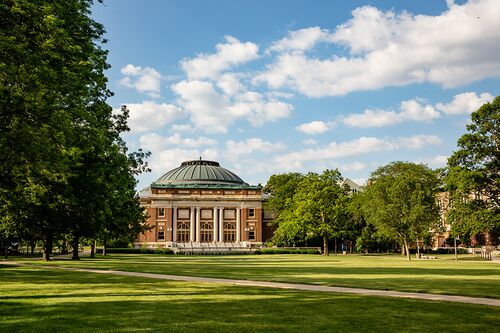What does refugee vetting look like on the ground?

Refugees seeking entry to the U.S. need “extreme vetting,” says the Trump administration in justifying its proposed travel bans. But U of I anthropology doctoral student Sophia Balakian, in her dissertation research, found that potential refugees already must endure an extensive and time-consuming process that can easily end in failure. Her project took her to Kenya in east Africa for a year and a half, where she studied the resettlement process through research with Congolese and Somali refugees and with U.N. and U.S. government officials. She spoke with News Bureau social sciences editor Craig Chamberlain.
Approximately how many refugees are there in the world today and what are their prospects?
There are over 21 million refugees worldwide, the vast majority of whom are living in the global South. The United Nations Refugee Agency talks about three durable solutions for refugees: integration into the countries to which they’ve fled, repatriation to their home country or resettlement to a third country.
For most refugees living in places like Kenya, official integration is impossible, as the government doesn’t provide refugees a path to citizenship. Repatriation isn’t feasible due to ongoing conflicts. This leaves resettlement. Yet, the number of resettlement spots made available by host governments like the U.S. enable the resettlement of less than 1 percent of all refugees.
What are refugee agencies looking for in selecting and processing families for possible resettlement? What criteria are used in judging which refugees are deserving and safe?
U.N. staff conduct the first layers of identification and screening, and forward cases to governments on the basis of legal or physical protection needs; experience of violence or torture; medical needs; risks faced by women and girls, and by children and adolescents; family reunification; and a lack of alternative durable solutions. Often the U.N. refers people who have already been living as refugees for several years. In sum, they are refugees who are deemed to be particularly vulnerable.
Those refugees who are referred to the U.S. government then undergo face-to-face interviews in the asylum country (in this case Kenya), first by staff contracted by the State Department and then by a Homeland Security official. The interviews are designed to ensure that applicants meet the Immigration and Nationality Act definition of “refugee,” and that they have never participated in terrorist or other criminal activity. Every applicant’s biometric data, like fingerprints, are checked against U.S. law enforcement and intelligence agency databases.
The U.S. also coordinates the vetting process with U.N. documentation: refugees’ testimonies are checked against the interviews they gave to U.N. staff over the course of many years, starting with their initial U.N. registration. Officials also scrutinize refugees’ narratives against published reports about conditions and events in the countries they fled.
Broadly, refugees must meet the definition of a refugee, be of special humanitarian concern, demonstrate honesty through consistent narratives over time, and show that they have never participated in terrorist or other criminal activities.
Based on your research, if you had to advise a refugee family newly arrived in Kenya and seeking resettlement in the U.S., what would you tell them about the process, the time and their chances?
I would tell a family: The vast majority of refugees living in Kenya won’t be resettled, because there simply aren’t enough spots for every deserving person. For those chosen for resettlement, the process takes a long time. In extremely fast cases that may mean a year or two, but for most it can be five or 10 years, or even longer. The process involves frustration and setbacks because of bureaucratic and policy changes, and often ends in disappointment.
In my research, it was difficult to be a realist with people for whom resettlement may be the only hope of getting out of a desperate situation. Yet, refugees are simultaneously aware of how the system works and hold on to hope anyway.
So why do so many refugees still seek to come to the U.S.?
Refugees continue to advocate for themselves or follow up on pending cases for years because they believe that life in the U.S. allows a kind of well-being that is impossible while living as refugees. Without citizenship, refugees in Kenya and many other countries are subject to police harassment, they can’t move freely within or across national borders, and they have few livelihood options. In the camps, many subsist on meager rations for years, if not decades. These are just a few of the challenges they face.
What I found in my research is that most refugees want a job, physical security and the chance for their children to have a future where their basic rights are protected. Some refugees have lived in peaceful and prosperous communities in the past, and all refugees know that greater peace and security exist elsewhere. Many refuse to give up hope that they, too, can have basic security, and more. Resettlement often appears to be the only path toward that end.








